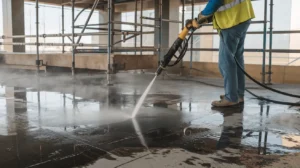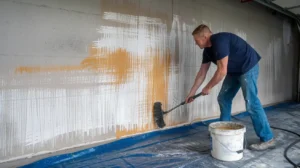Travertine is a popular natural stone used for floors, tiles, and showers due to its unique beauty and durability. However, cleaning and maintaining travertine requires special care to avoid damaging the stone.
In this guide, we’ll explore how to clean travertine effectively, including the essential tools and materials, cleaning travertine floors and tiles, treating grout stains, and maintaining travertine showers.
Essential Tools and Materials for Cleaning Travertine
Before you start cleaning, gather the following tools and materials:
- Soft-bristle broom or vacuum with a brush attachment
- Dry mop or microfiber cloth
- Neutral pH stone cleaner
- Warm water
- Mop bucket
- Non-abrasive sponge
- Clean towels or dry mop
- Soft brush for grout
- Travertine sealer
Having the right materials ensures that you clean your travertine without causing permanent damage to the stone.
How to Clean Travertine Floors
Cleaning travertine floors involves regular cleaning and occasional deep cleaning to maintain their beauty and longevity. Follow these steps for the best results.
Step 1: Sweep or Vacuum
Start by sweeping or vacuuming the travertine floor to remove dirt, dust, and debris. Use a soft-bristle broom or a vacuum cleaner with a brush attachment to prevent scratching the stone surface. Regular cleaning like this helps prevent dust and grit from grinding into the travertine floor tiles.
Step 2: Mix the Cleaning Solution
Mix a neutral pH stone cleaner with warm water in a bucket according to the manufacturer’s instructions. Avoid using acid cleaners or general floor cleaners, as these can damage the stone. A small amount of the right cleaning solution is enough to clean travertine effectively.
Step 3: Mop the Floor
Dip a soft mop into the cleaning solution and wring out the excess water. Mop the floor gently, working in sections to ensure the entire area is covered. Avoid using too much water, as travertine is porous and can absorb liquids, leading to stains or damage.
Step 4: Dry the Floor
After mopping, dry the floor with a clean, dry mop or towels. Leaving water on the surface can lead to staining or soap scum buildup. Ensure the floor is clean and dry to maintain the stone’s appearance.
How to Clean Travertine Tile
Travertine tile cleaning requires a similar approach to floor cleaning but with a few extra steps, particularly for dealing with grout lines and stubborn stains.
Mopping Travertine Tiles
For regular cleaning, mop travertine tiles with a neutral cleaner and warm water. Avoid using hot water, as it may cause damage to the stone. Make sure to clean the entire surface and follow up with a dry mop to prevent water absorption.
Scrubbing Travertine Tiles
For deep clean sessions or if you notice dirt buildup, use a soft sponge or non-abrasive brush to scrub the tiles gently. Be careful not to use any abrasive materials that could scratch the travertine stone.
Rinsing Travertine Tiles
Rinse the tiles with clean water to remove any remaining cleaning solution. Dry the tiles thoroughly with a soft cloth to avoid streaks or water spots.
Treating Grout Stains on Travertine
Grout lines between travertine tiles can easily accumulate dirt and stains. Use a soft brush and a small amount of the cleaning solution to scrub the grout. Avoid harsh chemicals, as they can damage both the grout and the travertine tiles.
Resealing Your Travertine Floor
One key to maintaining travertine is ensuring it’s properly sealed. Over time, the sealant can wear down, making the stone more susceptible to stains. Reseal your travertine floor every 1-2 years or as needed. After cleaning and drying the floor, apply a stone sealer according to the manufacturer’s instructions to protect it from future damage.
How to Clean Travertine Shower
Travertine showers require extra attention due to their constant exposure to water and soap scum. Here’s how to keep your travertine shower clean and in good condition.
Wipe down surfaces daily: After each shower, use a soft towel or squeegee to wipe down the travertine. This helps remove soap scum and prevent water stains from forming.
Deep clean weekly: Once a week, use a neutral pH stone cleaner and warm water to clean the travertine surfaces in the shower. Focus on areas where soap scum or mildew may accumulate.
Clean grout lines: Use a soft brush and cleaning solution to scrub grout lines. Avoid using harsh chemicals or acid cleaners that can damage the grout and stone.
Dry thoroughly: After cleaning, dry the travertine shower with towels to prevent moisture absorption and reduce the risk of mold or mildew.
Do’s and Don’ts Guide to Travertine Cleaning
Dos of Travertine Cleaning
Act Fast: Clean up spills immediately to prevent staining. Travertine is porous and can absorb liquids quickly, causing permanent damage.
Seal: Ensure your travertine is properly sealed to protect against stains and moisture.
Mop Regularly: Clean your travertine floors and tiles regularly with a neutral pH cleaner to prevent dirt and grime buildup.
Maintain Regularly: Regular cleaning and resealing can prolong the life of your travertine and keep it looking beautiful.
Don’ts of Travertine Cleaning
Don’t Vacuum Travertine Floors: Unless your vacuum has a brush attachment, avoid vacuuming travertine floors to prevent scratches.
Never Use General Floor Cleaners or Vinegar: Acidic cleaners like vinegar can cause etching and permanent damage to travertine. Always use a cleaner specifically designed for natural stone.
Don’t Try to DIY Resealing: Sealing travertine is a delicate process that should be done by professionals to ensure even coverage and long-lasting protection.
Conclusion
Knowing how to clean travertine properly ensures its beauty and durability for years to come. Regular cleaning, proper materials, and resealing are crucial to maintaining the natural stone. By following these steps, you can avoid permanent damage and keep your travertine looking pristine.
From cleaning travertine floors to showers, the key is to use the right cleaning products and avoid harmful substances like vinegar or general cleaners. Stick to neutral pH cleaners and ensure your travertine is properly sealed.
Whether you’re dealing with soap scum, grout stains, or regular dust, this guide will help you keep your travertine stone in excellent condition. Transform your space with our expert services contact us if you have any query or want to take our services.






